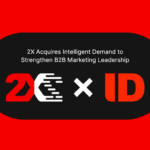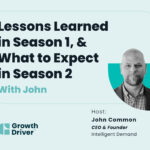
Revenue Leaders: Sangram Vajre, Chief Evangelist & Co-Founder at Terminus on Account Based and Alignment
If you own revenue at your B2B company, chances are you have bought into the idea of account based – but there is a big difference between talking about ABM, planning for ABM, and making ABM happen in the real world.
We’ve been doing ABM for quite some time now, and what we have learned along the way is that even though virtually everybody is at a different stage in their ABM journey, the same questions and challenges continue to arise. How do we align our Sales and Marketing teams? What are the important metrics? What tech do I need? And how do we scale?
We talked with one of ABM’s most sought-after speakers and practitioners Sangram Vajre, Chief Evangelist and Co-Founder of Terminus – a leading Account Based platform and the team behind the Flip My Funnel movement. Sangram has literally written the book on ABM, which is why we wanted to put him in our hot seat and see how he answered some of the most common account based questions.
What is the main reason organizations fail with ABM pilots?
Sangram: ABM fails because we have unrealistic expectations. Just like lead generation, we are so used to getting leads as a quick way to say, “yeah, that works”. And when you think about ABM, it’s not about getting leads, it’s about engagement. It takes time and it takes different types of metrics.
So, mismanaged expectations are why ABM pilots typically fail.
Who do I need on my team to make an account based strategy work?
Sangram: Sales. If you think just because ‘M’ is in there that its Marketing only, you’re missing a big part of it. It’s really ‘Account Based’ – and without sales ABM will fail.
How do I align my Sales & Marketing teams to make ABM work?
Sangram: We talk about this team approach, which is: target, engage, activate and measure. If you can get alignment around who you want to target, that’s like the base – it’s the first and most important thing. Get internal teams to agree that this is the list of accounts we’re going after, either for net new demand generation, pipeline acceleration or expansion strategy – it doesn’t really matter. You just have to get agreement and alignment between the internal teams on the target account list. Once you have that, everything else will work together.
That synergy is by far what brings the teams together to make ABM work.
My company is making the move from traditional lead-centric to account based marketing. What is the very first thing that we should do?
Sangram: I think it’s a real challenge in almost every single company, and by no means do I or any of us typically say, “hey, you need you to just completely just change to ABM”. But if you are a lead-centric company and you are moving towards account-centric, the first thing that I think you need to do is figure out is what are the right metrics to measure.
I’ll give you a quick example:
If you’re a lead-centric company, you would typically see website traffic going up and to the right as a good thing. If you become an account-centric company, which means you’re only focused on the right accounts, then you’re advertising and your engagement is all about those target lists of accounts. You actually might see (and this has happened to many of our customers for good reason) that your website traffic might go down. Typically, that would mean alarm bells all over saying, “Oh my goodness, marketing is not doing their job!”. When in reality, what you’re doing is getting the right people to engage with you on your website.
Bottom line, your metrics are going to change and the things that used to work and be false positives will all be very quickly demystified.
How do I discover multiple demand units or buying centers in each of my target accounts?
Sangram: For the most part, I think ABM involves a very targeted approach to doing things. Typically, you would figure out who your purchasing team is. When you think about it, if you want to sell into the IT function, the executive team persona is very different compared to the one who’s going to buy, who is very different from the one who is going to sign the documentation, who is very different from the [persona] that is going to use it…. So, the way you discover that is by simply going through the process of determining who is the end user. Start there. But don’t forget the people who are influencing that decision or have a stake in the ground – and all of those people are part of that account. Discovering them is really a matter of identifying the champions in the account and also the influencers in the account.
What is the best way to measure & report ABM success?
Sangram: I think we’re moving towards the idea of one scorecard, which means that Marketing and Sales are going to have the same metrics. Not similar – the same metrics. So, I would say the best thing to think about when it comes to ABM reporting are the metrics that the business cares about – the business outcomes.
So, pipeline velocity is really, really big. Up-sell and cross-sell, or retention rates are important because of how you’re engaging your customers and future customers, and your new pipeline that is generated from the target account list. None of these are typically what marketers are focused on. These are all sales or business outcomes.
So truly, ABM reporting is going to be no different than what business reporting should be.
Do you need technology to make ABM work?
Sangram: You actually don’t technology to do ABM at all. I was with a customer this morning and my recommendation to them was that they really weren’t ready for technology. Unless you have a good understanding of your target list of accounts and identify how you’re going to engage with them, technology will be a burden for you and a cost for you. If you’re just piloting and testing with a few accounts, you actually could do that with just the Sales and Marketing teams sitting together, figuring out the accounts and engagement tactics. But as you start to scale these accounts and say, “No, no, no. I don’t want to do it for 10 – I want to do it for 100″ or “I want to do it for 1000 now”, which a lot of companies are starting to do, then you do need technology to be able to scale it and to manage it.
Tell us about your new ABM course on LinkedIN…
Sangram: LinkedIn asked us to do a course for account based marketing because it’s such a hot topic and it needed to be vendor agnostic. It is for people who, as a group, as a team, or as individuals, not only want to know more about how to do account based marketing, but more importantly understand some of the use cases for demand generation, pipeline acceleration, and customer marketing. The course is less than one hour and has 19 different videos. Each video is four minutes and under, which very simply state the stages, the steps to take, how to do it, how to get started, and the team framework we talked about (target, engage, activate and measure). [Those who take the course] will learn how to use that team framework in real life, bringing sales and marketing together.
So, if you have a team or if you have individuals, both Marketing and Sales trying to understand how to do it, they literally can order pizza and get together at lunch time and go through these videos right then and there.
If you are a fan of Sangram and Terminus’ approach to account based, start by signing up for the LinkedIn course, and also make sure you pick up ABM is B2B!




